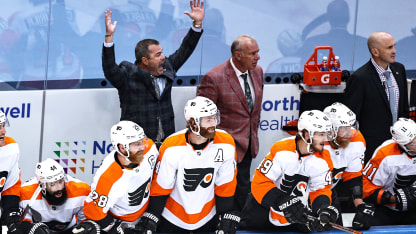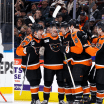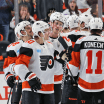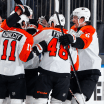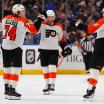WHAT WENT RIGHT
1. Closeouts in Montreal series
The Flyers were one of the NHL's best closeout teams during the regular season and round robin when leading after two periods. The team went 29-0-2 in games in which the team entered the third period with a lead.
In the round-robin, the Flyers took leads into the third period in all three games. Philadelphia came away with regulation wins of 4-1 (vs. Boston), 3-1 (vs. Washington) and 4-1 (vs. Tampa Bay).
During the First Round series against Montreal, it was stellar goaltending from Carter Hart and often-stifling team defense in the third periods that propelled the Flyers to victory in the series. The Flyers were able to nail down 2-1, 1-0, 2-0, and 3-2 victories to advance to the second round.
In the Second Round against the Islanders, the Flyers were technically 2-0 in the games they led within the third period. However, that statistical fact was deceptive.
The Flyers saw a 3-1 lead (originally 3-0) slip away in the third period of Game 2, only to rescue a 4-3 win in overtime. In Game 5, the Flyers took a 2-1 lead into the third period and added an insurance goal only for the Islanders to come back to tie the game and send it to overtime. The Flyers again won in OT.
Additionally, the Flyers lost Game 3 after taking a 1-0 lead to the first intermission. In Game 6, ultimately a 5-4 Flyers win in double overtime, Philadelphia had an early 2-0 lead and then had to battle back from deficits of 3-2 and 4-3.
Viewed on the season as a whole up through the Montreal series, the Flyers' cumulative 38-0-2 record when leading after two periods was no fluke. The final two of those wins were despite unsuccessful closeouts and not because of them.
2. Carter Hart
He wasn't infallible or without experiencing adversity in the playoffs, but overall, the Flyers' 22-year-old netminder was a huge reason why the team came within a single win of the Eastern Conference Final.
Hart was under siege in the majority of the games he played in the playoffs, and usually found ways to give the Flyers a chance to win. Despite giving up four goals in Game 6 of the Islanders series, Hart more or less ended of stealing that game for Philadelphia. His overall .926 save percentage (still second-best among all goalies competing in the playoffs this year) and the eye-popping volume of medium-to-high danger chances he erased were a crucial factor in why the Flyers got as far as they did.
There should be no question going forward if Hart -- after winning a pair of potential elimination games -- is up to the challenge of playing in the playoffs. when his team is getting outchanced and there's little to no margin for error. He can handle it.
3. Supporting cast offense
Except in a few specific games, the Flyers' core group of forwards largely had a disappointing playoff run, as they were unable to pick up where they left off the the time of the pause. There were, however, quite a few times all across the postseason when the Flyers got goals from other sources.
The team's blueline combined for eight goals across the 15 postseason games. That included overtime tallies for Phil Myers and Ivan Provorov in the New York series. Provorov also fired off a deflectable shot in Game 5 of the Islanders series that directly led to Scott Laughton's game-winning tip-in goal.
Laughton started and ended the postseason on strong notes but struggled in between -- including some uncharacteristic own-zone miscues -- during the Montreal series and Game 1 of the Islanders series. Offensively, he had three goals and five points in the round-robin and five goals and nine points overall in the playofffs to rank only behind Kevin Hayes in point production.
When healthy, Michael Raffl provided a spark. Along with strong boardwork and two-way play in the nine games in which he was healthy enough to dress, Raffl kicked in four goals and five points.
Nic Aube-Kubel had a two-goal game during the round-robin. Tyler Pitlick had a round-robin empty netter and scored the game's first goal in Game 3 against the Islanders. Twenty-year-old rookie Joel Farabee had some matchup-related ups and downs during the postseason but he was effective at times in getting puck touches and puck pursuit as well as contributing three goals and five points.
One exception to supporting cast offense up front was Derek Grant. He produced 14 goals for Anaheim, a career-high, before coming over the Flyers at the trade deadline. He then posted five points (1g, 4a) in seven games for the Flyers before the pause. Unfortunately, he was unable to recover that touch during the playoffs. With the exception of a nice assist via a behind-the-net passout on a Hayes goal in the series clincher against Montreal, Grant came up empty after the round robin.
4. Oskar Lindblom's return
In both the immediate sense and in the long-range picture, the biggest story from Games 6 and 7 was Oskar Lindblom's return to the lineup. It was inspirational to the entire team, and a benefit on the ice.
It had only been eight months after being diagnosed with Ewing's Sarcoma in his ribcage and two months after being diagnosed in remission after undergoing chemotherapy and rib resection surgery. Originally, the plan was for Lindblom to target a Game 1 return for the Eastern Conference Final if the Flyers made it to the Edmonton bubble.
Lindblom's hockey sense was still very much intact in his two playoff games, although his hands and feet were understandably a bit rusty and he's still working his way back to his regular playing weight. With the 2020-21 regular season not slated to start until December, Lindblom has an excellent outlook for getting back next season to the form he showed in the first two-plus months of the 2019-20 season.
WHAT WENT WRONG
1. Top Guns Often Struggled Offensively
With the exception of Hayes, who led the Flyers with four goals and 13 points in the postseason, the 2020 Stanley Cup playoffs were often frustrating offensively for most of the Flyers core group of forwards. Hayes had an uneven playoffs from a defensive standpoint, but he was in the middle of scoring chances in most of the team's 16 games.
Voracek also thrived at times in the postseason (4g, 5a), at least during the round-robin and especially during the Montreal series (where he was dominant at times). He had only one assist to show for the seven games against the Islanders -- more than that was needed from him -- but he was effective in making plays in segments of the three games the team won during the series especially in overtime.
Claude Giroux stepped up in Games 5 and 6 of the Islanders series but those games were an oasis in another rough offensive playoff run for the Flyers captain. The team needed more than eight points (1g, 7a) overall from him and situationally needed him to create more momentum-changing moments during the team-wide spells where they were defending more than attacking.
Selke Trophy finalist Sean Couturier was unable to duplicate his 2018 playoff heroics and struggled mightily to finish off scoring chances that could have difference makers in the games the Flyers lost to Montreal and New York. He missed several half-open nets and was unlucky on a few others that hit the post. Even as head coach Alain Vigneault worked to finagle more offensive-zone starts and some favorable-on-paper matchups for Couturier and his linemates, the payoffs were sporadic.
Couturier did score a nice goal off the rush in Game 2 of the Islanders' series, due to sheer determination. He scored a deflection goal in Game 4 that tied the game temporarily. He gutted his way through Game 7 on a torn MCL (as he did in two games against Pittsburgh in 2018) but little went his way. Overall, while Couturier's nine postseason points and four points in six games against the Islanders weren't disastrous, it would not be accurate to say the Flyers' top line matched or exceeded the threat created by their counterparts on the Islanders side.
James van Riemsdyk was a healthy scratch four times during the postseason. He did score in back-to-back matches in Games 5 and 6 of the Islanders' series but there were too many games in the postseason where he was ineffective.
Last but not least, Flyers regular-season goal-scoring and overall point scoring leader Travis Konecny had an extremely frustrating postseason in failing to score a goal and posting seven assists across 16 games.
Bottom line: The combined eight goals from Hayes and Voracek were workable for the Flyers. But the combined five goals from Couturier, Giroux, Konecny and and van Riemsdyk across the entire postseason -- plus Voracek not scoring again after the First Round -- made it very tough for Philadelphia to produce sufficient offense in enough games to reach the Eastern Conference Final. Plain and simple, the goal production from the core group was too fleeting and disappeared for too many of the games.
2. Special teams
During the regular season, the Flyers ranked 14th on the power play (which ran a bit excessively streaky, but acceptable in aggregate at 20.8 percent success) and 11th on the penalty kill at 81.8 percent (a significant improvement from 2019-20).
The Flyers power play scuffled during scrimmages late in training camp before reporting to the bubble (which was neither surprising nor alarming) and never got untracked but for a single game in the playoffs (was certainly not expected to that degree and proved quite costly in the long run).
With the exception of a 3-for-7 outburst in a losing cause in Game 5 of the Montreal series, the Philadelphia power play went AWOL after the league returned to play. The team was 4-for-50 going into Game 7 of the Islanders series, finishing 0-for-13 against the Islanders.
Meanwhile, after a strong start to the postseason on the penalty kill during the Round Robin and Game 1 of the Montreal series, the PK turned out to be erratic when it mattered the most. Thereafter, there were certain games or specific kills within games where the Flyers' killed penalties emphatically. There were also non-infrequent letdowns. The overall PK percentage of 80.5 percent wasn't terrible but the dearth of Flyers power play goals to balance off anything yielded with a Flyer in the box forced the team to have to win games almost exclusively at 5-on-5.
To advance to a Conference Final or a Stanley Cup Final, there are going to be some games where winning the special teams goal differential proves to be the deciding factor in a few victories. The Flyers did not help themselves whatsoever in that regard during this postseason.
This tells the story: A special teams index number (combined power play and PK percentages) of 100 is adequate, and anything below 100 is a detriment. Anything from 105 or up is stellar. The Flyers were at 102.6 during the regular season, solidly in the top half of the league. In the postseason, they slipped to 88.5 including 7.7 percent on the power play.
3. Puck possession disadvantages
During the regular season and the majority of the round robin (except when leading in the third period by multiple goals), the Flyers were a good puck possession team this year. They were the NHL's stingiest team in terms of shots allowed per game, and was on the positive end overall of both the shot attempt and high-danger scoring chance ledgers at five-on-five.
Correspondingly, the Flyers as a team were +18 (153 GF - 138 GA) in their goal differential at five-on-five in the regular season. Those advantages disappeared dramatically in the playoffs.
This was somewhat expected against Montreal, which was the NHL's No. 2 puck possession metrics team in the league during the regular season and heavily relied on throwing shots on net from all angles because they lacked much in the way of pure scorers.
By regular season numbers, this was less expected against the Islanders, which 29th in 5-on-5 shot attempt differentials and 20th in expected goals differential based on shot quality. But the playoff Islanders in the first two rounds were a different team against Washington and the Flyers.
Seeing that Montreal was able to forecheck the Flyers into an accelerated number of turnovers on attempted defensive zone exits and clears, the Islanders dialed up their forecheck on the Flyers, too. Philadelphia had trouble coping in particular with some of big, strong forwards on the Islanders (such as Brock Nelson and Anders Lee) as well as the highly skilled Mathew Barzal and some of their speedy forwards. Notably, the Islanders found success in creating offensive from behind the Flyers net.
Vigneault found some some adjustments that worked for a time -- high flips out of the D zone with neutral zone pressure for recoveries, reversing the puck along the boards and breaking out on the less congested opposite side -- but the Flyers continued to hurt themselves with some particularly egregious turnovers and several coverage breakdowns that ended up in their net.
Overall, among the 24 teams that reached the postseason, the Flyers exited ranking 18th in 5-on-5 shot attempt differential (47.58 percent) and 18th in expected goal differential (44.65 percent). That put an awful lot of pressure on your defense, your goalies and the need to be very efficient and opportunistic when you do get a scoring chance.
Until the series finale, there was at least one period per game in the Islanders series where the Flyers had the better of territorial play and scoring chances: the 2nd period of Game 1, the 1st period and overtime of Game 2, the 1st period of Game 3 (mainly the first 10 minutes), the 2nd period of Game 4, the first period and overtime of Game 5, and the second OT of Game 6. A few other periods were territorially even at five-on-five. Overall, though, that was a recipe for getting worn down in a long series.
Long series or not, and notwithstanding the heart and effort that it took to come back to force a Game 7 after trailing three games to one, the Flyers' performance in the final game is going to sting whenever this playoff year is recalled.
Philadelphia controlled the play for the first six-plus minutes, including a deflection that went off the post and earning the game's first power play. After a coverage breakdown by van Riemsdyk that led to a Scott Mayfield goal and then one by Voracek that contributed directly to one scored on the other side by Andy Greene, the Flyers made very little pushback. Philadelphia was limited to nine shots on goal through two periods and 16 overall in a 4-0 loss.
With the season on the line, that wasn't even in the ballpark of what was needed.
Overall, it would be fair to say that going 3-0-0 in the round robin and 4-0-0 to start the playoffs raised false hopes that the team would be able to get back to the level the team achieved during the 26 games leading into the league's four-and-a-half month stoppage for the Covid-19 pandemic.
4. Great start, rough finish for Sanheim and Myers
The Flyers second defense pair of Travis Sanheim and Phil Myers thrived on the early end of the playoffs with their play in all three zones. By the Islanders series, although they were still making some strong plays up ice, both halves of the pairing struggled at times individually and collectively. Turnovers of both the pressured and unforced varieties were particular bugaboos in the New York series.
The emergence of this pairing behind the top duo of Provorov and Matt Niskanen was a huge part of the Flyers' surge in the second half of the 2019-20 season regular season and their 4-0-0 start to the postseason in going into the Isles series with a 7-2-0 record in the Bubble.
Niskanen himself had a rough spell during the playoffs. In his case, it was primarily during the round-robin and Montreal series although he was later a key figure in two killer goals against in the third period of Game 4 of the Islanders series. Overall, though, Niskanen pulled things back together in the Second Round especially in Games 5 and 6. Fellow veteran Justin Braun also had some rough patches in the playoffs.

